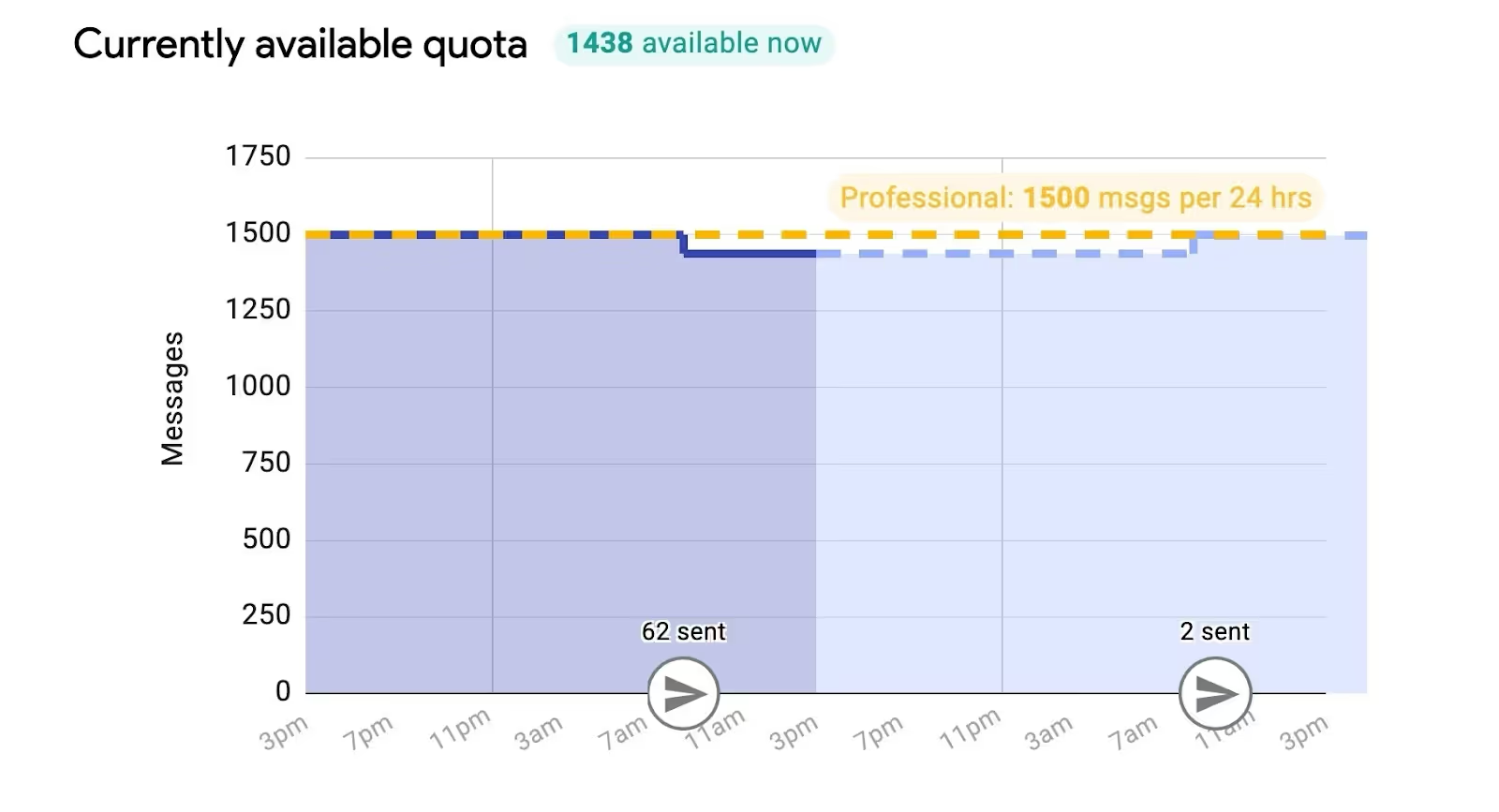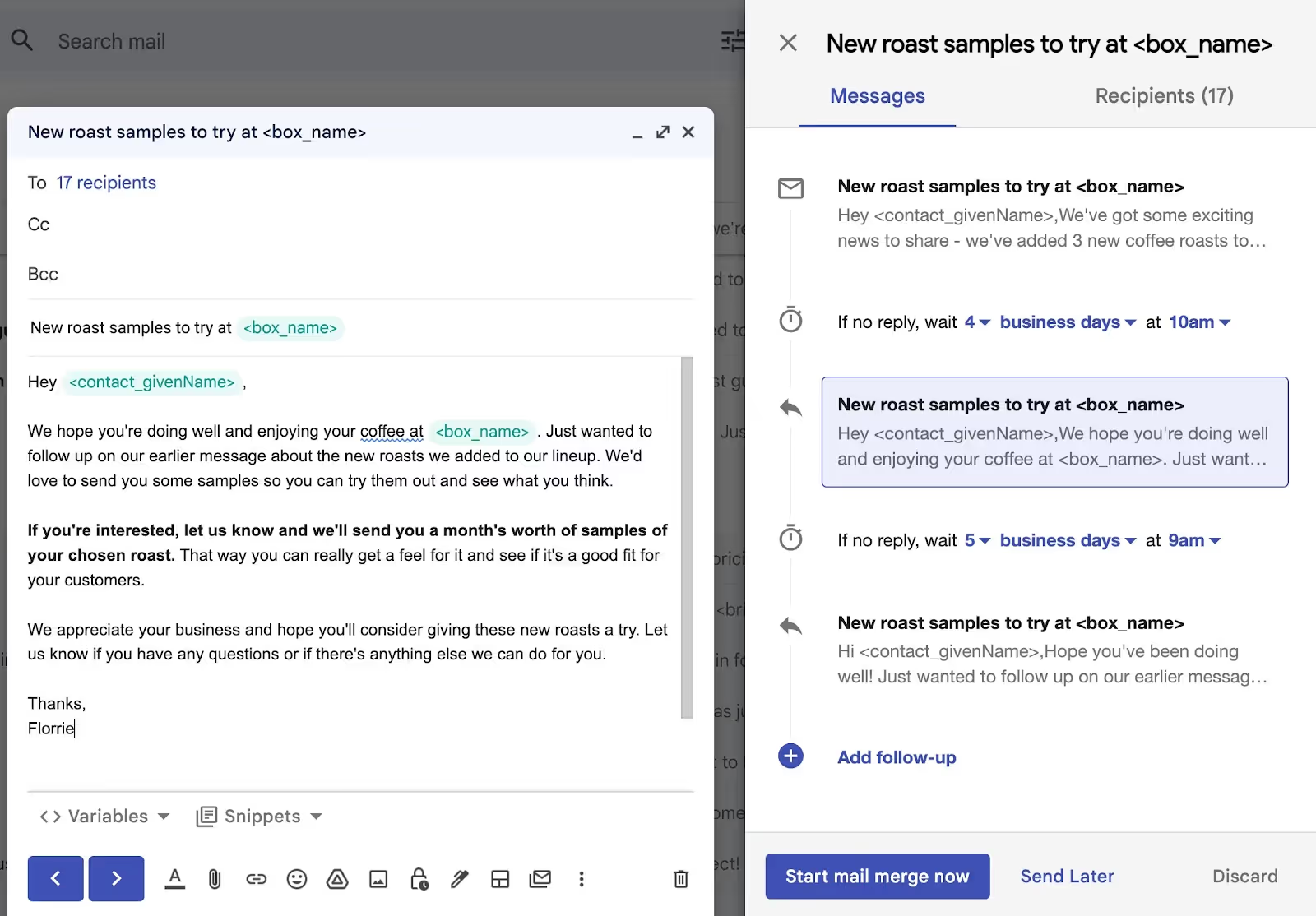New Gmail mail merge (previously Gmail multi-send)
Learn all of the features and limitations of Gmail's new multi-send mode for sending mail merges and mass emails in Gmail.
Gmail's 1.8 billion users send countless emails each day, yet few grasp the invisible controls keeping everything running smoothly. Behind the scenes, Gmail sets restrictions limiting how many outgoing emails you can send per day. Without these limits, the flood of mail could overwhelm recipients and enable spammers.
So how many emails can you send at once in Gmail?
In this guide, we'll show you the number of emails you can send depending on your account type, what happens if you hit the maximum number of emails, and how you can increase and improve your email outreach.
Understanding Gmail sending limits per day can help you maintain email deliverability and avoid triggering account holds.
{{cta-box}}
Depending on which type of Gmail account you have, your daily sending limit will vary.
If you have a standard Gmail account (one that ends in “@gmail.com”), your daily sending limit is capped at 500 emails in a rolling 24-hour period.
A Google Workspace account lets you use a custom email domain with Gmail.
If you’re using a Workspace account, Gmail offers a more generous daily sending limit of up to 2,000 emails in a rolling 24-hour period.
If you’re using a mail merge tool in Gmail, you can send up to 1,500 messages daily via mail merge. Mail merge messages count towards your 2,000 total.
Your Gmail daily sending limit is the same for emails you send on mobile devices.
If you are currently exploring Google Workspace with a free trial, you won’t have access to the full 2,000 daily sending limit.
You can send the full number of daily emails once your domain has converted to a paid Google Workspace account, cumulatively spent $100, and 60 days have passed since that payment threshold was met.
Gmail does this to limit people from opening dozens of new accounts to send spam right away.
<div class="anchor-wrapper"><div id="types-of-messages" class="anchor-target"></div></div>
Every email sent from your account is included in the daily sending limit. This includes emails sent from a Gmail alias, delegated users, and from out of office messages or vacation responders.
<div class="anchor-wrapper"><div id="timeframe-for" class="anchor-target"></div></div>
The timeframe for Gmail's daily email-sending limit is a rolling 24-hour period. This means the limit doesn't simply reset at midnight but instead counts the emails sent in the last 24 hours every hour.
For example, with a standard gmail account:
<div class="anchor-wrapper"><div id="hitting-the-limit" class="anchor-target"></div></div>
If you hit the 24-hour Gmail sending limit, you may see a message that says “You have reached a limit for sending mail.”
In this scenario, Gmail puts a temporary hold on your ability to send emails to ensure fair usage and prevent spam.
You should be able to send emails again within 1 to 24 hours, depending on how many you sent at various times throughout the prior 24-hour period (see example above).
<div class="anchor-wrapper"><div id="check-your-sending" class="anchor-target"></div></div>
While you can always count through your sent messages folder in Gmail, there’s not a clear way to track your daily sending limit within your Gmail account.

Using a tool like Streak’s mail merge can help you track how many messages you’ve sent via mail merge so you know exactly how close you are to the daily sending limit and when you'll be able to send additional messages.
<div class="anchor-wrapper"><div id="avoid-hitting" class="anchor-target"></div></div>
If you’re regularly sending emails to large groups of people, create a distribution list through Google Groups with all of your recipients. Rather than sending individual emails, just send your message to the group’s address.
<div class="anchor-wrapper"><div id="happens-to-emails" class="anchor-target"></div></div>
Emails don't get sent after you hit the limit. Besides notifying you of the limit, Gmail will notify you of what messages did not go through.
During this time, you can create drafts of emails to schedule or send later.
<div class="anchor-wrapper"><div id="best-practices-and-tips" class="anchor-target"></div></div>
Even if you’re staying within Gmail’s daily sending limit, effectively sending bulk emails in Gmail requires some know-how to avoid ending up in the spam folder.
In fact, In 2024 Gmail is introducing requirements and new protections to reduce spam and make sure Gmail continues to be a valuable service for both senders and receivers.
You can adhere to Gmail's requirements and improve your email deliverability by:
<div class="anchor-wrapper"><div id="google-workspace" class="anchor-target"></div></div>
With a Google Workspace account, you can send up to 2,000 emails per day (1,500 mail merge) compared to the standard Gmail limit of 500. This is important if you want to run mass email campaigns and reach a broader audience without worrying about hitting the daily limit.
To get started, you’ll need to set up a custom email domain for your business or organization.
<div class="anchor-wrapper"><div id="authenticate-your-emails" class="anchor-target"></div></div>
Implement authentication protocols such as SPF (Sender Policy Framework), DKIM (DomainKeys Identified Mail), and DMARC (Domain-based Message Authentication, Reporting & Conformance). This not only adds credibility to your communications but also shields them against spoofing attempts.
<div class="anchor-wrapper"><div id="segment-your-contact" class="anchor-target"></div></div>
Segmentation makes your emails more relevant to specific groups in your list. Smaller segments also help you stay within Gmail sending limits.
In practice, you could segment your email list based on various criteria like purchase history, geographical location, or even engagement level, identifying those who frequently open your emails versus those who don't.
<div class="anchor-wrapper"><div id="personalize-emails" class="anchor-target"></div></div>
Using a recipient’s first name is the bare minimum for personalization.
Tailoring the content to align with their interests or past interactions with your brand takes it to the next level. For instance, if one of your B2B prospects just released a book, you could mention that in the subject line and the opening line of your email.

Use a tool like Streak mail merge to add variables to the subject line and body of your emails. This allows you to create and send up to 1,500 personalized emails in bulk each day.
<div class="anchor-wrapper"><div id="plan-larger-campaigns" class="anchor-target"></div></div>
Planning larger email campaigns over a stretch of days is a smart move. This helps you steer clear of Gmail's daily sending thresholds and keep communication effective.
You could send a batch of emails focused on a new product line to those who've shown interest in similar items in the past. Then, consider scheduling automatic follow-up to re-engage users who haven't interacted with your emails in a while.
Sending these emails out in carefully planned intervals means you can catch your audience when they're most likely to engage.
But planning doesn't stop once emails are sent. Keeping an eye on how these emails perform — who opens them and who clicks through — is crucial. This feedback loop allows you to tweak and improve future campaigns.
<div class="anchor-wrapper"><div id="clean-email-lists" class="anchor-target"></div></div>
A clean email list means you're only sending emails to addresses that are valid, active, and free from duplicates. This is important because when you send emails to outdated or incorrect addresses, you're likely to encounter high bounce rates and spam complaints. These issues can negatively impact your sender reputation and the deliverability of your emails.
Audit your list regularly to avoid these issues. This process involves removing any email addresses that are no longer valid or have been bouncing back.
For an extra layer of assurance, you can use an email verification service. These services can check your list for invalid emails before you send out your campaign. They can verify if an email address is correctly formatted and if the domain exists, so your emails are being sent to real, active email addresses.
<div class="anchor-wrapper"><div id="structure-content" class="anchor-target"></div></div>
Optimizing your email content for mobile devices is key considering the majority of emails are now opened on smartphones and tablets. Long subject lines might get cut off on smaller screens, so aim for impact in fewer words.
For the email body, a single-column layout works best. It streamlines the reading experience, making it easier for your audience to scroll through your message without the need to zoom in or out.
The text in your emails should be legible and the design responsive. Responsive design means your email adjusts to fit the screen it's being viewed on so it looks great whether it's opened on a desktop or a mobile device.
And with calls-to-action (CTAs), size and clarity matter. Buttons and links should be large enough to tap comfortably with a thumb.
<div class="anchor-wrapper"><div id="use-streak" class="anchor-target"></div></div>
Streak is a powerful CRM and email outreach tool that integrates directly into Gmail, making it easier to manage your email campaigns without switching between applications.
Use Streak mail merge to:
Install the Streak extension and start a free 14-day trial to try sending mail merges from Gmail.

Send personalized mail merges with automatic follow-up or schedule emails to send later with Streak mail merge in Gmail. Send free mail merges daily.